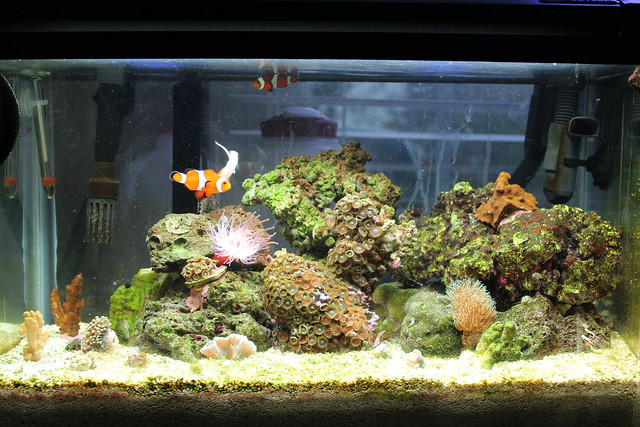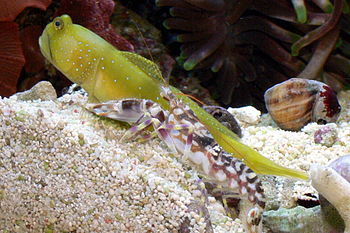 |
| 14 liter (3 gallons) nano reef containing small and large polyped stony corals (Photo credit: Wikipedia) |
1. Essential Planning
I recommend starting out with one of the commercially available nano aquariums on the market. These systems come complete with the tank, hood, lighting, and filtration - all you'll need to do is add sand, live rock, water, and a heater. Simplicity is your friend with a nano aquarium! I especially recommend the Oceanic's BioCube models, which come in 8, 14, and 29 gallons. With an all in one nano aquarium, the only additional equipment you'll need to purchase is a heater!
Once you've gotten the aquarium and other essential hardware, now the fun begins. Add aragonite sand (I'm not a fan of bare bottom aquariums) to a depth of .5-3" before adding freshly mixed salt water (cover the sand with a bowl to prevent it from going everywhere!). Ensure the water has a specific gravity of ~1.025, and a pH of 8.3-8.4, and a temperature of ~75-78F before adding live rock.
In a nano reef aquarium, live rock combined with water movement will be all the filtration you'll need. A pound of rock per gallon of water is the general rule of thumb, though more can be used if you'd prefer. Break up laminar (stream) currents by directing them on rocks or the tank walls to produce more natural, turbulent water motion. Try to elevate the live rock, creating 'shelves' for future corals. Quality live rock is essential - do not skimp on live rock just to save a few dollars. I have found Gulf View rock to be of excellent quality and fairly priced.
2. Stocking
Stocking options for a nano aquarium are very limited, and you should plan your purchases! Small fish such as some clownfish, damsels, dottybacks, basslets, and gobies will work well, but you won't be able to keep very many. Pick one or two small fish to enjoy, but resist overstocking. If you want to keep larger fish, a nano aquarium isn't for you.
Another benefit of an all-in-one tank is the built-in lighting if you're interested in keeping corals. Many species of corals also make excellent candidates for the nano aquarium, such as zoanthids, ricordia, leather corals, mushrooms, and more. Be sure to research potential tank mates to make certain you can provide a suitable home.
Some of the all-in-one nano aquariums have enough lighting so that more advanced aquarists can stock 'SPS' (stony) corals, and other light demanding invertebrates. While not recommended for the beginner, success is certainly possible for a knowledgeable aquarist.
3. Water Quality
At one point, I was having a lot of trouble maintaining proper water quality. I was using various additives, which would cause my water chemistry to go out of whack because of the small water volume, which would lead to more water chemistry problems, causing a never-ending cycle of problems. I finally realized something so simple it should have occurred to me sooner: stop using additives, and just stick to water changes! Weekly water changes of 50-75% are highly recommended to remove wastes and replace trace elements and calcium, especially if you plan on turning your nano aquarium into a nano reef. Just make sure your mix water is the same pH, temperature, and salinity as your tank water!
This "Nano in a Nutshell" guide should get you on your way to your first successful setup, but don't neglect further reading as a tool to help you continue to achieve success with your new nano aquarium! Don't forget to stop by my blog at blog.captive-aquatics.com for more valuable information about freshwater, saltwater, and reef aquariums!
More information about freshwater aquariums, saltwater aquariums, reef aquariums, and ponds can be found at The Captive Aquatics Blog For aquarium service, design, maintenance, installation, help, or consulting, visit the Captive Aquatics Homepage Article Source: EzineArticles |


